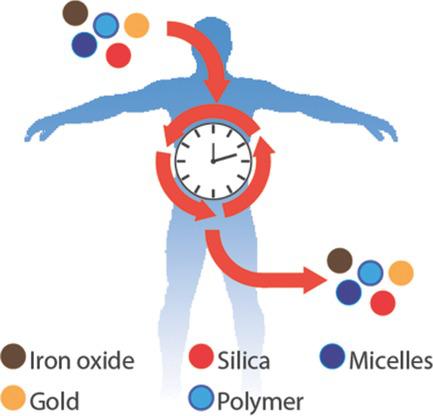当前位置:
X-MOL 学术
›
Adv. Mater.
›
论文详情
Our official English website, www.x-mol.net, welcomes your feedback! (Note: you will need to create a separate account there.)
Biodistribution, Clearance, and Long‐Term Fate of Clinically Relevant Nanomaterials
Advanced Materials ( IF 29.4 ) Pub Date : 2018-02-01 , DOI: 10.1002/adma.201704307 Joël Bourquin 1 , Ana Milosevic 1 , Daniel Hauser 1 , Roman Lehner 1 , Fabian Blank 2 , Alke Petri-Fink 1, 3 , Barbara Rothen-Rutishauser 1
Advanced Materials ( IF 29.4 ) Pub Date : 2018-02-01 , DOI: 10.1002/adma.201704307 Joël Bourquin 1 , Ana Milosevic 1 , Daniel Hauser 1 , Roman Lehner 1 , Fabian Blank 2 , Alke Petri-Fink 1, 3 , Barbara Rothen-Rutishauser 1
Affiliation

|
Realization of the immense potential of nanomaterials for biomedical applications will require a thorough understanding of how they interact with cells, tissues, and organs. There is evidence that, depending on their physicochemical properties and subsequent interactions, nanomaterials are indeed taken up by cells. However, the subsequent release and/or intracellular degradation of the materials, transfer to other cells, and/or translocation across tissue barriers are still poorly understood. The involvement of these cellular clearance mechanisms strongly influences the long‐term fate of used nanomaterials, especially if one also considers repeated exposure. Several nanomaterials, such as liposomes and iron oxide, gold, or silica nanoparticles, are already approved by the American Food and Drug Administration for clinical trials; however, there is still a huge gap of knowledge concerning their fate in the body. Herein, clinically relevant nanomaterials, their possible modes of exposure, as well as the biological barriers they must overcome to be effective are reviewed. Furthermore, the biodistribution and kinetics of nanomaterials and their modes of clearance are discussed, knowledge of the long‐term fates of a selection of nanomaterials is summarized, and the critical points that must be considered for future research are addressed.
中文翻译:

临床相关纳米材料的生物分布,清除和长期命运
实现纳米材料在生物医学应用中的巨大潜力,将需要对它们与细胞,组织和器官之间如何相互作用的透彻了解。有证据表明,取决于其理化性质和随后的相互作用,纳米材料确实被细胞吸收。然而,对材料的随后释放和/或细胞内降解,转移至其他细胞和/或跨组织屏障的转运仍知之甚少。这些细胞清除机制的参与极大地影响了所用纳米材料的长期命运,尤其是如果人们还考虑了反复暴露的话。几种纳米材料,例如脂质体和氧化铁,金或二氧化硅纳米颗粒,已被美国食品和药物管理局批准用于临床试验;然而,关于它们在体内的命运,仍然存在巨大的知识鸿沟。在此,对与临床有关的纳米材料,其可能的暴露方式以及必须克服才能有效的生物学障碍进行了综述。此外,讨论了纳米材料的生物分布和动力学及其清除方式,总结了对选择纳米材料的长期命运的认识,并阐述了未来研究必须考虑的关键点。
更新日期:2018-02-01
中文翻译:

临床相关纳米材料的生物分布,清除和长期命运
实现纳米材料在生物医学应用中的巨大潜力,将需要对它们与细胞,组织和器官之间如何相互作用的透彻了解。有证据表明,取决于其理化性质和随后的相互作用,纳米材料确实被细胞吸收。然而,对材料的随后释放和/或细胞内降解,转移至其他细胞和/或跨组织屏障的转运仍知之甚少。这些细胞清除机制的参与极大地影响了所用纳米材料的长期命运,尤其是如果人们还考虑了反复暴露的话。几种纳米材料,例如脂质体和氧化铁,金或二氧化硅纳米颗粒,已被美国食品和药物管理局批准用于临床试验;然而,关于它们在体内的命运,仍然存在巨大的知识鸿沟。在此,对与临床有关的纳米材料,其可能的暴露方式以及必须克服才能有效的生物学障碍进行了综述。此外,讨论了纳米材料的生物分布和动力学及其清除方式,总结了对选择纳米材料的长期命运的认识,并阐述了未来研究必须考虑的关键点。



























 京公网安备 11010802027423号
京公网安备 11010802027423号